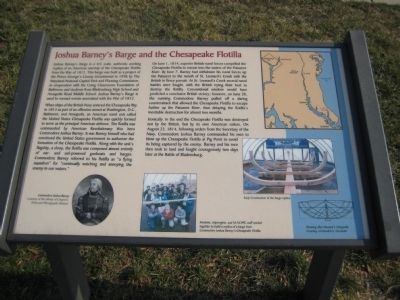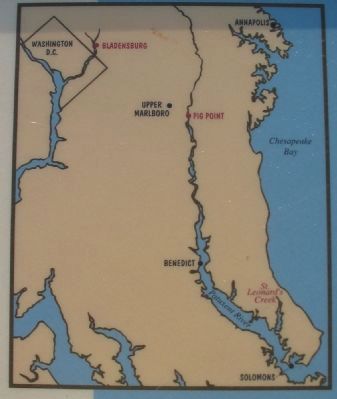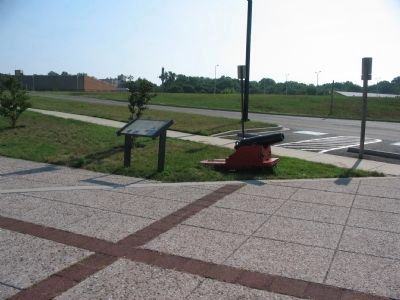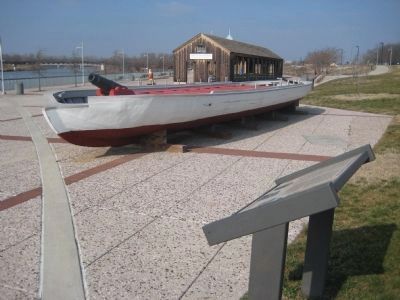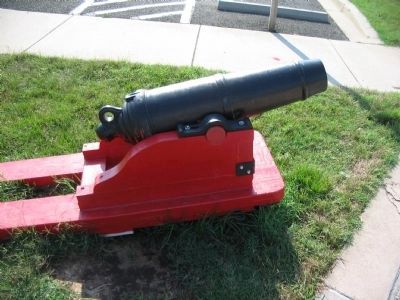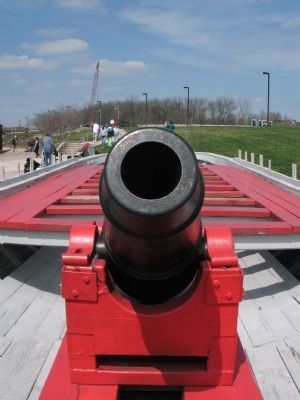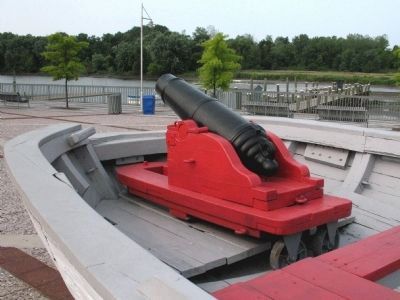Bladensburg in Prince George's County, Maryland — The American Northeast (Mid-Atlantic)
Joshua Barney's Barge and the Chesapeake Flotilla
Inscription.
Joshua Barney's Barge is a 4/5 scale, authentic working replica of an American warship of the Chesapeake Flotilla from the War of 1812. This barge was built as a project of the Prince George's County tricentennial in 1996 by The Maryland-National Capital Park and Planning Commission, in cooperation with the Living Classrooms Foundation of Baltimore and students from Bladensburg High School and Annapolis Road Middle School. Joshua Barney's Barge is used to reenact events associated with the War of 1812.
When ships of the British Navy entered the Chesapeake Bay in 1813 as part of an offensive aimed at Washington, D.C., Baltimore, and Annapolis, and American naval unit called the United States Chesapeake Flotilla was quickly formed to serve as the principal American defense. The flotilla was commanded by American Revolutionary War hero Commodore Joshua Barney. It was Barney himself who had convinced the United State Government to authorize the formation of the Chesapeake Flotilla. Along with the unit's flagship, a sloop, the flotilla was composed almost entirely of oar- and sail-powered gunboats and barges. Commodore Barney referred to his flotilla as "a flying squadron" for "continually watching and annoying the enemy in our waters."
On Jun 1, 1814, superior British naval forces compelled the Chesapeake Flotilla to retreat into the waters of the Patuxent River. By June 7, Barney had withdrawn his naval forces up the Patuxent to the mouth of St. Leonard's Creek with the British in fierce pursuit. At St. Leonard's Creek several naval battles were fought, with the British trying their best to destroy the flotilla. Conventional wisdom would have predicted a conclusive British victory; however, on June 26, the cunning Commodore Barney pulled off a daring couterattack that allowed the Chesapeake Flotilla to escape further up the Patuxent River, thus delaying the flotilla's inevitable destruction for almost two months.
Ironically, in the end the Chesapeake Flotilla was destroyed not by the British, but by its own American sailors. On August 22, 1814, following orders from the Secretary of the Navy, Commodore Joshua Barney commanded his men to blow up the Chesapeake Flotilla at Pig Point to avoid its being captured by the enemy. Barney and his men then took to land and fought courageously two days later at the Battle of Bladensburg.
Text with lower-left photo: Commodore Joshua Barney
Text with lower-middle photo: Students, shipwrights, and M-NCPPC staff worked together to build a replica of a barge from Commodore Joshua Barney's Chesapeake Flotilla.
Text with middle-right photo: Early Construction of the barge replica
Text with lower-right drawing: Drawing after Howard I. Chappelle Courtesy of Donald G. Shomette.
Topics. This historical marker is listed in these topic lists: War of 1812 • Waterways & Vessels. A significant historical month for this entry is June 1772.
Location. 38° 56.065′ N, 76° 56.301′ W. Marker is in Bladensburg, Maryland, in Prince George's County. Marker can be reached from the intersection of Annapolis Roade (Maryland Route 450) and 46th Steet. Marker is in Bladensburg Waterfront Park, .2 miles south of the entrance at this intersection. Touch for map. Marker is in this post office area: Bladensburg MD 20710, United States of America. Touch for directions.
Other nearby markers. At least 8 other markers are within walking distance of this marker. Clearing the Way to Washington (here, next to this marker); Bladensburg Floods (1742-1954) (a few steps from this marker); The First Telegraph Line (1844) (within shouting distance of this marker); Colonial Ropemaking (within shouting distance of this marker); Encampment of Coxey's Army (1894) (within shouting distance of this marker); Railroad History in Bladensburg (about 300 feet away, measured in a direct line); Dinosaur Alley (about 300 feet away); Duels and the Bladensburg Dueling Grounds (about 300 feet away). Touch for a list and map of all markers in Bladensburg.
Also see . . . Wikipedia entry for Joshua Barney. (Submitted on July 24, 2009, by Richard E. Miller of Oxon Hill, Maryland.)
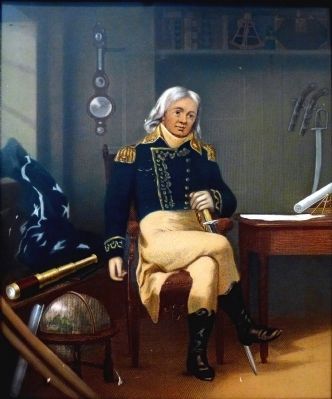
Photographed By Allen C. Browne, June 11, 2013
8. Commodore Joshua Barney
This portrait of Joshua Barney is in the U.S. Naval Academy Museum Collection.
“Barney served in the Continental Navy and, after the Revolution, he joined the French Navy, and commanded a squadron.
At the outbreak of the War of 1812, he commanded the privateer Rossie. Upon entering the US Navy as a captain Barney submitted a plan to the Navy Department to use a flotilla of shallow-draft barges, each equipped with a large gun to attack and annoy the British in the Chesapeake Bay.
After the destruction of his gunboat flotilla, Barney took about five hundred Marines and flotillamen to Bladensburg, Maryland, to help defend the capital. Barney's detachment held its ground until flanked and overwhelmed. In the action, Barney was wounded.” — Naval Academy Museum
“Barney served in the Continental Navy and, after the Revolution, he joined the French Navy, and commanded a squadron.
At the outbreak of the War of 1812, he commanded the privateer Rossie. Upon entering the US Navy as a captain Barney submitted a plan to the Navy Department to use a flotilla of shallow-draft barges, each equipped with a large gun to attack and annoy the British in the Chesapeake Bay.
After the destruction of his gunboat flotilla, Barney took about five hundred Marines and flotillamen to Bladensburg, Maryland, to help defend the capital. Barney's detachment held its ground until flanked and overwhelmed. In the action, Barney was wounded.” — Naval Academy Museum
Credits. This page was last revised on June 16, 2016. It was originally submitted on June 8, 2008, by F. Robby of Baltimore, Maryland. This page has been viewed 3,927 times since then and 39 times this year. Photos: 1. submitted on June 8, 2008, by F. Robby of Baltimore, Maryland. 2, 3. submitted on July 18, 2010, by Craig Swain of Leesburg, Virginia. 4. submitted on June 8, 2008, by F. Robby of Baltimore, Maryland. 5. submitted on July 18, 2010, by Craig Swain of Leesburg, Virginia. 6, 7, 8. submitted on June 14, 2015, by Allen C. Browne of Silver Spring, Maryland.
